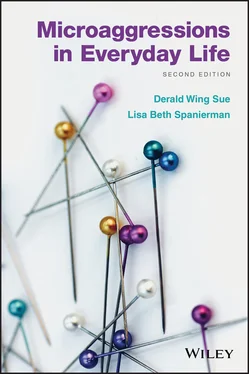Robert Guthrie, an African American psychologist, in the late 1970s produced the first edition of his now‐classic book Even the Rat Was White , which took psychology to task for being primarily a White Eurocentric field, neglecting the contributions of people of color in historical storytelling, and unintentionally elevating the contributions of one group (primarily White males) while denigrating Asian, African, and Latin American contributors through “benign neglect.” The hidden message to students of color was that White American psychology is universal and superior (other psychologies are inferior), and that students of color should accept this “reality.” White students are affirmed, but students of color feel that their identities are constantly assailed or ignored in the classroom. Black students are likely to expend considerable emotional energy protecting their own integrity while at the same time being distracted from fully engaging in the learning process (D. W. Sue, Lin, Torino, Capodilupo, & Rivera, 2009). Researchers documented a similar finding among South Asian Canadian undergraduate students (Poolokasingham, Spanierman, Kleiman, & Houshmand, 2014).
Second, Professor Richardson seems to equate rational discourse with approaching topics in a calm and objective manner. When he tells the Black student to “calm down” and implies that students are “too emotional,” the professor may unintentionally be delivering another racial microaggression with multiple hidden fears, assumptions, and biased values: (a) Blacks are prone to emotional outbursts, can get out of control, and may become violent; (b) emotion is antagonistic to reason, and conversations in the classroom should be unemotional and objective; and (c) the communication style of many Black individuals is dysfunctional and should be discouraged (D. W. Sue & Sue, 2008). Pathologizing Black communication and learning styles has been identified as a common microaggression directed toward African Americans (Constantine & Sue, 2007; D. W. Sue, Capodilupo, Nadal, & Torino, 2008). Studies suggest that communication and learning styles of Black Americans may differ from those of White Americans (DePaulo, 1992; Hale, 2016; Kochman, 1981). For example, affect, emotion, and passion are considered positive attributes of communication among Black Americans because they indicate sincere interest and seriousness toward the material or subject matter while objectivity and unemotional responses indicate insincerity and lack of connection.
Third, some of the Black students found Professor Richardson's compliment of Justin's intelligent analysis and his ability to articulate the issues to be offensive. Why? To answer this question requires an understanding of historical racial stereotypes and their interactional dynamics. This situation is very similar to what occurred in the 2007 to 2008 democratic presidential primaries when both Senators Joe Biden (White) and Barack Obama (Black) announced their candidacies. After announcing his presidential run, Mr. Biden was asked by a reporter about the public's wild enthusiasm for a Black candidate, Barack Obama. Joe Biden responded, “I mean, you got the first mainstream African‐American who is articulate and bright and clean and a nice‐looking guy. I mean, that's a storybook, man.”
There was an immediate uproar from many in the Black community who considered the statement insulting and offensive. To them, it represented a racial microaggression. Senator Biden, for his part, could not understand why a positive comment toward a fellow Democrat would evoke anger from Black Americans. It is important for us to understand that messages often contain multiple meanings. Although on the surface, the comment by Biden can be interpreted as praise, the metacommunication (hidden message) is “Obama is an exception. Most Black individuals are unintelligent, inarticulate, dirty, and unattractive.” Such a racial microaggression allows the perpetrator to acknowledge and praise a person of color but also allows him or her to express group stereotypes. In other words, while praising the Black student might have come from the professor's best intentions, the comment was experienced as a microaggression because it seemed to indicate that the professor was surprised that a Black student could be capable of such insightful and intelligent observations.
Like racism, sexism can operate at an overt conscious level or at a covert and less conscious one (Swim & Cohen, 1997). Blatant, unfair, and unequal treatment of women can be manifested in sexual harassment, physical abuse, discriminatory hiring practices, or women being subjected to a hostile, predominantly male work environment. Like overt racism and hate crimes, such sexist acts are strongly condemned by our society, and many men have become increasingly sensitive to their sexist actions (D. W. Sue & Sue, 2008). As our society has become more aware of what constitutes sexism and its harmful impact on women, the conscious, intentional, and deliberate forms of gender bias have seemingly decreased but also continue in the form of subtle and unintentional expressions (Butler & Geis, 1990; Fiske, 1993; Swim & Cohen, 1997). These subtle forms of sexism are similar to aversive racism in that they come from well‐intentioned men who believe in gender equality and would never deliberately discriminate against women. Yet these men unknowingly engage in behaviors that place women at a disadvantage, infantilize or stereotype them, and treat them in such a manner as to deny them equal access and opportunity (Benokraitis, 1997; Fiske & Stevens, 1993; Glick & Fiske, 2001; Swim, Aikin, Hall, & Hunter, 1995).
Similar to aversive and symbolic racism, theories of sexism identify both overt and covert forms—old‐fashioned and modern manifestations (Glick & Fiske, 1996; Swim & Cohen, 1997; Swim et al., 1995). Glick and Fiske (1996) put forth ambivalent sexism theory to describe two different but complementary expressions of sexism. Hostile sexism is consistent with the overt brand of sexism we see in television shows like Mad Men and The Handmaid's Tale . It refers to the inherent superiority of men, which justifies their dominant position over women. In contrast, benevolent sexism is subtle in that it refers to chivalrous expressions of male superiority (Becker & Wright, 2011). Although seemingly positive, benevolent sexism restricts women's roles and perpetuates male dominance via stereotypic views of women (e.g., nurturing and deserving of men's protection).
Women report that gender microaggressions occur frequently and devalue women’s contributions, objectify them as sex objects, dismiss their accomplishments, and limit their effectiveness in social, educational, athletic, employment, and professional settings (Banaji & Greenwald, 1995; Basford, Offermann, & Behrend, 2014; Benokraitis, 1997; Caplan & Ford, 2014; Kaskan & Ho, 2016; Morrison & Morrison, 2003). In the world of work, for example, many women describe a pattern of being overlooked, disrespected, and dismissed by their male colleagues (Sojo, Wood, & Genat, 2016). During team meetings in which a female employee may contribute an idea, the male chief executive may not respond or seemingly may not hear the idea. However, when a male coworker makes the identical statement, he may be recognized and praised by the executive and fellow colleagues. It has been observed that in classrooms, male students are more frequently called on to speak or answer questions by their teachers than are female students. The hidden messages in these microaggressions are that women's ideas and contributions are less worthy than those of their male counterparts.
In Example 1.2involving Kathleen's job interview, several common gender microaggressions were delivered to her by well‐intentioned male commuters and the interviewer.
Читать дальше












